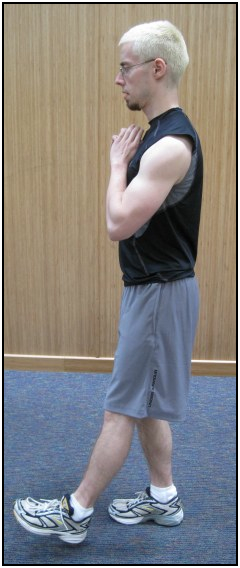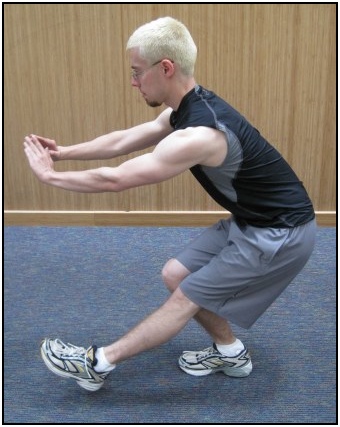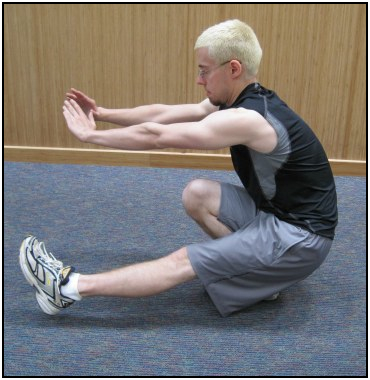Single Leg Squats:
Get The Pointers You Need
Single leg squats, also known as 'pistols' or 'pistol squats,' are a great body weight exercise. Even without weights you can make your legs ludicrously strong.
Weight training is one of the best methods of strength training! If you want to start weight training safely and effectively, with the best info, diet, and routines, check out the 5 Day Beginner Weight Training Course!
First you need to get comfortable with regular body weight squats. Then there're a few different methods you can use to work up to doing a full one legged squat, and then consecutive body weight squats.
Check out the different squat methods below, but remember: single leg squats are really advanced, so don't feel bad if it takes you a while to work up to them!
First: Regular, 2-Foot Deep Squat
- Stand with your feet slightly wider than shoulder width apart.
- Keeping your back straight (but not straight up), bend your knees and squat down till your thighs are parallel to the floor. Then, with good posture, stand back up.
This is a basic, unweighted squat. Once you can do that, try squatting down till you can't squat any further, until your butt touches the back of your ankles.
Once you can do these easily, say 20 - 30 of them in a row without losing your breath and keeping good form, you're ready for bigger things. You get to start working on single leg squats.
Use these two methods (or a combination of them) to work up to the one leg squat.
Barbell or Dumbbell Squat
These exercises are great for working up to the single leg squat. Start doing deep weighted squats to get your legs stronger.
As your legs get stronger with two legged squats, you'll find your attempts to do single leg squats get easier and easier. This worked out great for me.
The first time I was really able to do one legged squats, I had been focusing on increasing my regular barbell squat weight. After getting up around squatting twice my body weight, one squats were a cinch.
Box Squat
(Until You Reach The Full Single Leg Squat)
Box squats are an effective method for working up to single leg squats. They gradually increase your single leg squat range of motion till you can do a full single leg squat.
Box squats are very popular with Pavel Tsatsouline, a Russian strength training guru who really thinks highly of this training method. I appreciate this method, but think that weighted two legged squats are easier to use to work up to the pistol squat.
For box squats, you squat down on one leg until you reach the box, and then stand back up. Pretty simple.
But, here are some explicit instructions for the pistol squat if you're interested:
- First, make sure you carry tension through your whole body, especially hamstring tension in back of your legs, which keeps your knee protected from some very un-fun injuries.[1]
- Keep your weight on your heel and squat down as far as you can. Keep your back straight, lean your head and back forward, and reach forward with your hands to keep your balance.[2]
- Go down as far as you can, until your butt hits the box/chair/support-that-you-set-up, and then straighten your leg and stand back up.
Start with a box that is high enough that your thigh is parallel to the ground at the bottom of the movement.[3] As you get stronger, slowly decrease the height of your box/chair/support to expand your range of motion until you are doing full single leg squats.
How To Do One Legged Squats Photo Guide
Here's how to do the one legged squat...



My Single Leg Squat Difficulties
I personally found the balance aspect to be the most difficult part of the single leg squat. Barbell and dumbbell two legged squats build your leg strength, but it's still difficult to keep upright and not feel totally wobbly on one leg.
Balance Tip:
I learned this doing internal martial arts. First, imagine that there is a thread attached to the top of your head pulling your spine taut and up, and another attached to your butt pulling it down.
This 'pulling up and pulling down' creates a connection of tension running along your spine. It'll make it much easier to keep your balance on the way down and up.
Also, allow your non-squatting foot to hover just above the surface of the floor. Don't try to hold it out parallel to the floor the entire time. That's a good hip flexor exercise, but really brutal, and it's more important initially to focus on the squatting leg's exercise.
Other than that, just keep trying. They won't be perfect when you start, but with practice you'll get stronger and improve your balance. Pretty damn good for an exercise without any equipment ;-)
Tips
- Do not bounce at the bottom of your squat.
- Aggressively drive your hips forward as you stand up from the squat.[4]
- Keep your body tight the whole time.
- Keep your foot flat on the floor during the whole movement, especially at the bottom. No twisting or contorting it to make standing up easier.[5]
Variations
- To make it harder, switch legs at the bottom of the squat and stand up with the other leg. Try this only after you're got the regular pistol squat down pat.[6]
- Try pausing at different points in the one leg squat (parallel, almost all the way down, etc.) to make the movement harder.[7]
- Try adding weight once you can do the regular one leg squat. Hold a light dumbbell or kettlebell to make the movement more difficult.
- Try the alternate movement of standing on a chair, desk, or something else standing up and doing a single leg squat from there. Let one of your legs hang limp while the other does the squat.
This is an especially helpful variation if you have weak hip flexors and holding your other leg out in front is difficult. You can focus fully on just the leg doing the squatting.
Concerns and Safety Points
Make sure you stretch your hip flexors between your sets. It may be hard to hold your non-squatting leg out in front of you at the beginning, so...
- Work up your squats gradually, and...
- Really make sure you stretch your hip flexor muscles (the ones that get sore in your upper thigh and the base of your hip)![8]
Also, if you have knee problems, this exercise probably isn't for you. You can try doing it slowly, and with good geometry and technique, but this can tweak your knees. Be warned.
Keep your shin bone as vertical as possible. This exercise can put a lot of strain on your knee and shin, but you can minimize this by keeping your shin as close to vertical as possible during the entire movement.[9]
Keep your body straight and tight the entire time. No rotating, curving, contorting, etc. to try to stand up when you can't. Now go try out the one legged squat!
Oh, and be sure to sign up for the e-zine Starting Strong to get monthly strength training, exercise, and diet tips e-mailed to you - and access to the free e-book Train Smart, Eat Smart: Exercise Nutrition Hacks!
• Click HERE to learn more about body weight exercises!
OR
• Click here to leave 'Single Leg Squats: Get The Pointers You Need' & go back to the Home-page!
References:
1. Tsatsouline, Pavel. 2004. The Naked Warrior: Master The Secrets Of The Super-Strong, Using Bodyweight Exercises Only. St. Paul, MN: Dragon Door. Pp. 107.
2. Ibid. Pp. 110.
3. Ibid. Pp. 104.
4. Ibid. Pp. 124.
5. Ibid. Pp. 111.
6. Ibid. Pp. 131.
7. Ibid. Pp. 140.
8. Ibid. Pp. 118.
9. Ibid. Pp. 110.
Search CST...
|
Tweet Follow @Aaron_CST |
|
"About 2 weeks ago I read all the ab strengthening stuff on your site because I decided I wanted to be strong, instead of having a lot of belly fat. So I started eating healthier, running, exercising, you name it - everything your site said to do to help. Now I am noticing a real difference! Thank you for making this. :D xD" ~ Julia |
|
[This calorie calculator is] the most useful tool on the web that I can find… Also, I compared the calories calculated by your calculator to the calories calculated by the treadmill at my gym, and they're within a couple calories of each other, so yours is as accurate as we're going to get. REALLY AWESOME TOOL. I love it and depend on it. Thank you sooooo much for making this available." ~ Galit Sharon Marcus |
|
Thank you very much, I was too lean before 2 years (55 Kgs), after the gym now I'm 72kgs, all the muscles have developed... when someone hand shakes with me it can be squeezed easily, they're making fun of me! ~ Tamil Arasan |






New! Comments
Have your say about what you just read! Leave me a comment in the box below.